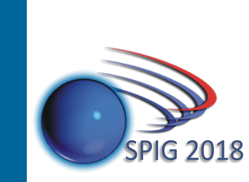
About SPIG
Symposium and Summer School on Physics of Ionized Gases (SPIG) was initiated 52 years ago as an international conference in the fields of:
Atomic Collision Processes - Electron and Photon Interactions with Atomic Particles, Heavy Particle Collisions, Swarms and Transport Phenomena;
Particle and Laser Beam Interactions with Solids - Atomic Collisions in Solids, Sputtering and Deposition, Laser and Plasma Interaction with Surfaces;
Low Temperature Plasmas - Plasma Spectroscopy and other Diagnostic Methods, Gas Discharges, Plasma Applications and Devices;
General Plasmas - Fusion Plasmas, Astrophysical Plasmas and Collective Phenomena.
These four disciplines have strong interactions in numerous applications, however, due to the development of specialized international conferences, it has become increasingly rare that such a wide range of topics is covered at a single conference. As the four fields often overlap and merge in numerous fundamental studies and more importantly applications, SPIG serves as a venue for exchanging ideas in the four related fields. Besides the typical proceedings of contributed papers with abstracts of invited lectures and progress reports, the complete invited lectures and progress reports are published in book form under the title "Physics of Ionized Gases". The published papers are selected after peer review of the submitted manuscripts. These books have become not only a significant source of scientific information but also important textbooks for postgraduate students worldwide.
Besides the formal presentations of scientific papers, a Summer School on Physics of Ionized Gases is always organized as a part of the SPIG conference. The aim of the School is to encourage young scientists to present their scientific, and especially, Ph.D. results in a forum that includes some of the world's leading experts in their particular fields. Thus, SPIG offers a chance for the exchange of a wide range of important technical information that is useful to all participants.
Although the number of international conferences on this and similar topics is growing and the competition between conferences is strong, SPIG has had enviable success in attracting a large number of scientists to Yugoslavia every two years.
The SPIG conferences are always organized by one of the major laboratories in Serbia and Montenegro (former Yugoslavia), but it is international in character with an international scientific committee and a large number of invited speakers from all around the world. Most of the leading scientists in the fields related to SPIG have attended the conference at some stage. The tendency for the conference is to become a regional (Balkan and mid -European) center for this field of science, as it serves the purpose of connecting large body of scientists that have limited funds for attending conferences worldwide with the leading researchers in the fields of the conference and thus it helps maintain international scientific standards in the region. SPIG is held every two years and in the recent years typical number of participants was 150-200 including 30 invited speakers and 10 progress reports. Approximately 50% of participants are from a large number of different countries, mostly European and from Japan.
Detailed history of SPIG conference can be found in the article SPIG from beginning to today.
Websites of the previous SPIG conferences:
- SPIG 2016
- SPIG 2014
- SPIG 2012
- SPIG 2010
- SPIG 2008
- SPIG 2006




